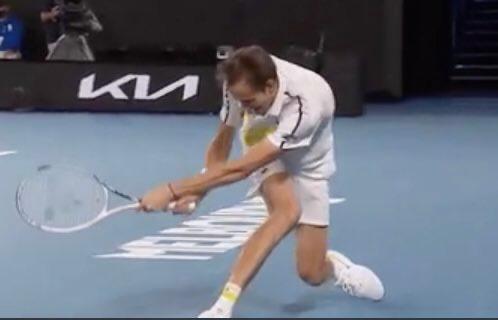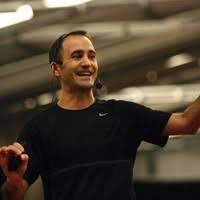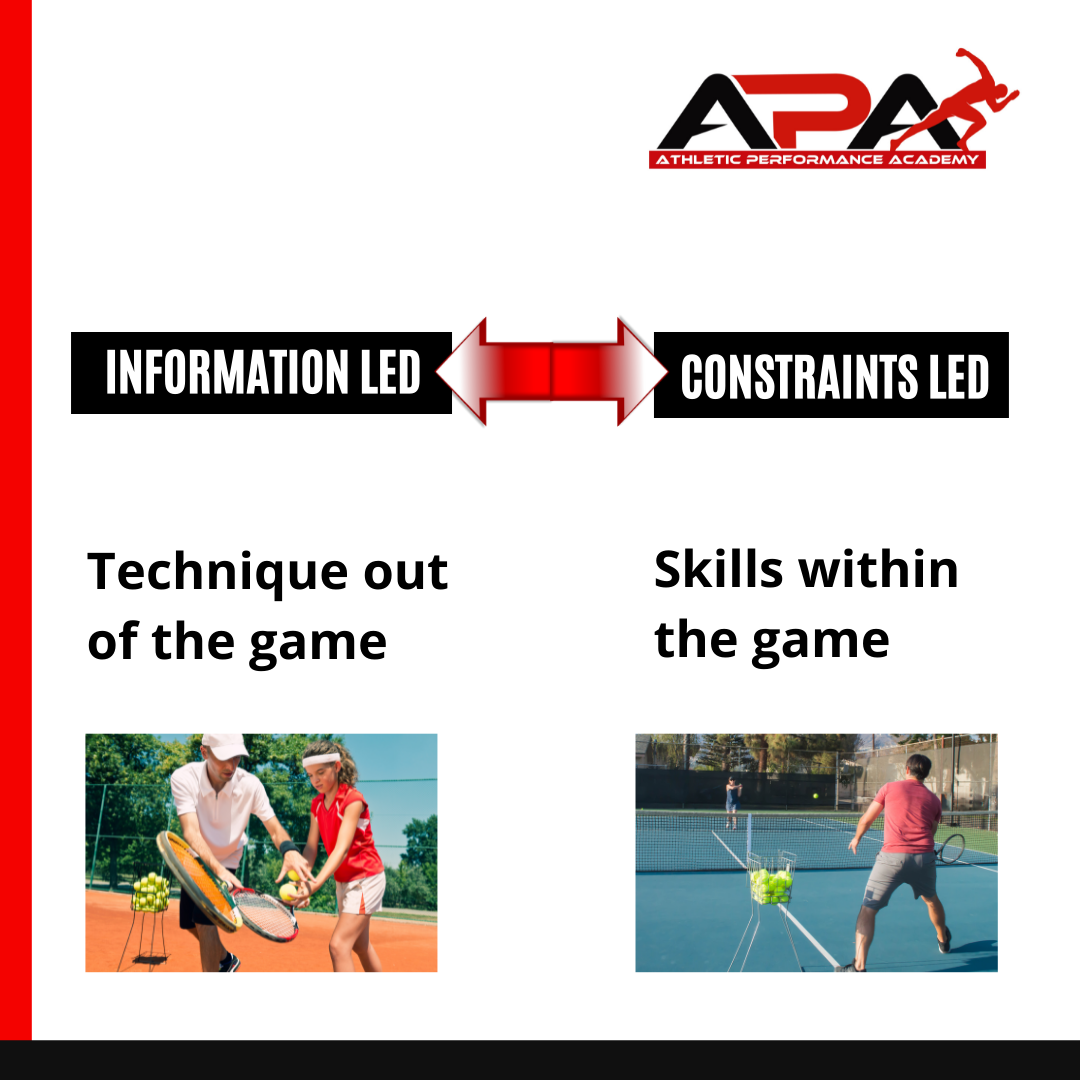Task based drills vs Game based skills- why it matters
This year one of my friends and colleagues Sergio Gomez-Cuesta (who is the Head of Performance, Science and Medicine Support and 10U Player Development Lead at Gosling Tennis Academy) has been running some coach education for Gosling coaches on coaching frameworks designed to maximise skill acquisition and development in Tennis players.
Despite constraints based coaching being a rapidly evolving part of skill acquisition theory and practice it is certainly not new.
I can’t believe that it is 2014 when I first wrote about the influence of cognitive factors on physiological performance. How time flies!
Truth be told, at that point in time, I wrote about it but didn’t make any real changes in my coaching framework, and from speaking to coaches I get the sense I wasn’t alone. A lot of coaches seem to be aware of these new coaching terms such as ecological dynamic systems, constraint based coaching, implicit versus explicit coaching etc. But for whatever reason are not necessarily incorporating them into their current coaching practices.
This was me in 2014. It’s less me now in 2022. So what changed? Well, first of all I have a coach to thank, Gabe Fishlock, who was a breath of fresh air. He had just joined the team and started working with the existing syllabus at APA for 12-under and 10-under players for one term (April-July), and asked if he could re-vamp it for September, and put his mark on it.
Having the Courage to Change
This was a break through moment for both of our coach development- for Gabe- because he was a new kid on the block and showed tremendous courage to ask if he could tinker with something that he knew full well was personally written by me and at the time I was pretty happy with. A break through for me, because I had to have the courage to let go of any attachment to something, acknowledge there were better ways to do things, and hear it from/trust someone with much less experience to show me how to do it!
To summarise the change in curriculum, it went from task-based drills to game-based skills
Now before I go any further with this blog, I want to discourage any coach from seeing this in black & white- I’m not here to tell you that drills are bad and you should never use drills to enhance technique, and neither am I here to tell you that you should only use games.
Instead, I just want to share with you a clear ”shift” in my approach with an ”emphasis” on a few key principles. I’ll talk about some of them below and try and illustrate them with examples.
Coaching Principles
Technique
- Perception- shapes our actions (not instructions from coaches)
- Self organisation – leads to individualised optimal technique
- Optimal technique – leads to adaptability
The first time I learnt about the difference between ‘technique’ and ‘skill’ was on by Football Association (FA) Level 2 Certificate in Football coaching in 2000.
Technique – the action without the context
Skill – the technique in context
Style – the individual adaptability of technique
”Expert tennis players apply the same biomechanical principles and technique BUT with DIFFERENT individual styles.”
👆 This photo went viral on social media showing Daniel Medvedev (current World Number 1 ATP Tour) getting into a ‘sub-optimal’ position. Strength & conditioning coaches were cuing up to comment on this. Okay, so it doesn’t look great, right?
You wouldn’t want to use this as the ‘technical model’ of movement to a running backhand. But I’m guessing you wouldn’t mind being World Number 1 in one of the most brutally demanding sports on the planet (my opinion)? Now, I’m not going to get too side tracked and make this a post about Medvedev’s technique but it is a good illustration of technique versus style.
For the record, I can’t remember what the outcome was of the point- I don’t know if he made the ball, he played a winning shot or he stayed in the rally, so someone please feel free to let me know! But what I can say is that several tennis coaches have already done various commentaries of his ‘technique,’ and found that although it doesn’t look easy on the eye, it apparently conforms to the most important biomechanical principles (which I’m guessing are things like contact point of racket in relation to body etc). It’s not just about how you get there, it’s about where you get to.
As I said in my 2014 post,
”It is only the level of performing skill based tasks under pressure that creates the ranking in terms of the best performers.’‘
This doesn’t mean I no longer pay attention to the textbook technical model, or have a preference for one way of executing a task over or another. Neither does it mean that I no longer guide beginners towards this technical model. But, as we will see below, it’s about how you guide the learner with your coaching. This is what I mean by the coaching framework.
So, moving onto the topic of coaching framework, let’s say we now have some understanding of the difference between technique and skill, how do you actually coach that?
Coaching Framework
I’ll break this down into the WHAT, the WHY and the HOW
The WHAT
Below is an adapted version of a slide Sergio shared with us. An example of information led coaching would be a tennis coach standing next to the player (BOTH ON BASELINE) while dropping a ball for the player to hit, while they are standing still.
An example of context and constraints led coaching would be a tennis coach feeding the ball to a player across the net.
Information Led Approach
I was educated in the 1990s and 2000s so a lot of my knowledge and education in skill acquisition was based on the traditional motor learning theory of skill acquisition, which basically says that the ‘motor programme’ is the key thing. Essentially it views skill learning as a software programme (or technique) that we need to upload to the hardware- and our bodies are like robots that learn by MEMORISING techniques in isolation as the most effective way to ‘upload the programme.’
Learning is DONE TO THE PLAYER- learning is about the player practicing and repeating solutions GIVEN TO THE PLAYER by the coach.
Constraints Led Approach
In this approach the perception-action coupling is the key thing. The context in which the skills are learnt is the most important thing.
Learning is DONE BY THE PLAYER- learning is about practicing and repeating the process of finding the solutions BY THE PLAYER.
The WHY
What [information] the player PERCEIVES shapes their ACTIONS (this is referred to in the scientific literature as ACTION-PERCEPTION coupling).
What the player perceives shapes their actions MORE OPTIMALLY and without consciously thinking than instructions.
Example – a player has an elbow too close to their body when hitting a forehand. The coach can ‘instruct’ them to straighten their arm, or the coach can create a physical barrier to increase the height of the net, which affords the player the opportunity to solve the problem by perceiving what happens to the ball when they explore different ways to get the ball over the net.
This leads nicely to the last point of today’s post- the HOW.
The HOW
Create a boundary within a competitive GAME-LIKE SITUATION that requires the technical/tactical skills instead of giving explicit detailed solutions and instruction. This brings us back to where we started which is the title of the blog – Task based drills vs Game based skills- why it matters.
I still don’t feel I’ve done a good enough job of going over the WHY – yes I’ve mentioned that what the player perceives shapes their actions MORE OPTIMALLY than instructions.
But just to add to that, we as coaches can all probably agree we want LONG-TERM transfer to performance. We want the skills to stick under high pressure, this is something we call ‘self-organisation.’ This is the natural ability that humans have to find solutions under constraints and without micromanaging and instructions.
”The technical skill blueprint that emerges is the most individualised, stable, flexible, context dependent and rapidly available movement solution to deal with pressure situations and super-fast sports.”
(S Gomez-Cuesta)
Now before all the purists jump in and say that beginners need to be instructed first, and they don’t have the tools to get to the ‘correct’ or ‘optimal’ solution on their own, can I first please refer you back to my 2014 blog. In it I talk about working with beginners. I totally hear you, you’re worried that athletes may learn poor movements and adopt bad habits. This would only happen if you did the equivalent or throwing someone who couldn’t swim into the deep end and watch them drown. Of course you have to guide them, and choosing where they need to spend their time so that they can safely progress.
To use the swimming analogy, they still get in the water, and you might even have them get their feet off the floor (even if it means wearing arm bands or using other flotation devices) but they are still swimming. No swimming teacher would expect a child to learn to swim if they just stood still in the shallow end up to their waist in water swinging their arms backwards and forwards- yet this is what we do every week on the tennis court!
In summary we can view the role of the coach as guiding the athlete to optimal performance through giving them a clear instruction on the intent we are looking for, and a few attentional cues BUT letting them solve the movement problem!
Hope you have found this article useful.
Remember:
- If you’re not subscribed yet, click here to get free email updates, so we can stay in touch.
- Share this post using the buttons on the top and bottom of the post. As one of this blog’s first readers, I’m not just hoping you’ll tell your friends about it. I’m counting on it.
- Leave a comment, telling me where you’re struggling and how I can help
Since you’re here…
…we have a small favor to ask. APA aim to bring you compelling content from the world of sports science and coaching. We are devoted to making athletes fitter, faster and stronger so they can excel in sport. Please take a moment to share the articles on social media, engage the authors with questions and comments below, and link to articles when appropriate if you have a blog or participate on forums of related topics. — APA TEAM






